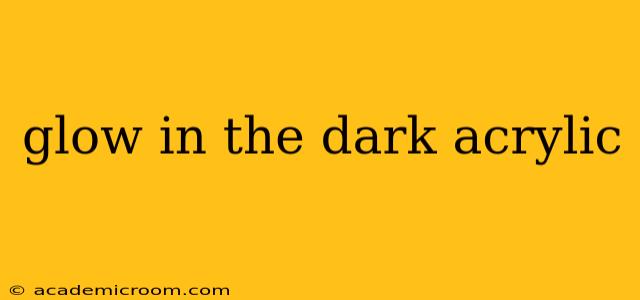Glow-in-the-dark acrylic paints and resins are captivating materials offering a unique way to add luminescence to your artwork, crafts, and even home décor. This comprehensive guide dives deep into the world of glow-in-the-dark acrylics, exploring their properties, uses, and the best practices for achieving stunning results. Whether you're a seasoned artist or a curious beginner, this guide will illuminate (pun intended!) your path to creating mesmerizing, glowing masterpieces.
What is Glow-in-the-Dark Acrylic?
Glow-in-the-dark acrylics are pigments that incorporate phosphorescent materials, typically based on rare earth elements like strontium aluminate. Unlike fluorescent materials that require a constant light source to glow, phosphorescent pigments absorb light energy (UV and visible light) and then slowly release it as a visible glow over an extended period. This "afterglow" can last anywhere from several minutes to several hours, depending on the quality and type of pigment used and the duration of the charging period. The acrylic binder allows for easy application and offers the versatility typical of acrylic paints and resins, enabling a wide range of creative applications.
How Long Does Glow-in-the-Dark Acrylic Glow?
The duration of the glow from glow-in-the-dark acrylic depends on several factors:
- Pigment quality: Higher-quality pigments generally offer a longer and brighter glow. Cheaper pigments may glow for a shorter duration and with less intensity.
- Charging time: The longer the material is exposed to a light source, the longer and brighter it will glow. Direct sunlight or a strong UV source provides optimal charging.
- Environmental conditions: Temperature and humidity can affect glow duration. Cooler temperatures generally lead to a longer glow.
- Color of the glow: Brighter glows tend to fade faster. A less intense glow may last longer.
While some high-quality pigments can provide several hours of glow, expect a more typical glow time of 30 minutes to a few hours after a sufficient charging period.
What is the Difference Between Fluorescent and Phosphorescent Glow in the Dark Paint?
This is a crucial distinction. Fluorescent paint requires a constant light source (like a blacklight) to glow. The glow ceases immediately when the light source is removed. Phosphorescent paint, on the other hand, absorbs light energy and then emits it slowly over time, creating the characteristic glow-in-the-dark effect. Glow-in-the-dark acrylics are almost exclusively phosphorescent.
How to Make Glow-in-the-Dark Acrylic Paint Glow Brighter?
Maximizing the brightness and duration of your glow-in-the-dark acrylic creations involves several strategies:
- Charge it thoroughly: Expose your painted surface to a bright light source (sunlight is ideal) for a prolonged period before turning off the lights to observe the glow.
- Use high-quality pigments: Investing in premium glow-in-the-dark pigments will yield a significantly brighter and longer-lasting glow.
- Apply multiple coats: Multiple thin coats of glow-in-the-dark acrylic paint will generally produce a more intense glow than a single thick coat.
- Consider the background color: Darker backgrounds will make the glow appear more vibrant.
What are the Different Uses of Glow-in-the-Dark Acrylics?
Glow-in-the-dark acrylics open up a world of possibilities for creative expression and practical applications. Some popular uses include:
- Art and painting: Create luminous landscapes, abstract art, and unique portraits.
- Craft projects: Decorate resin jewelry, personalize phone cases, or add a glow to model kits.
- Home décor: Design glowing wall art, furniture accents, or even light switches.
- Safety applications: Mark walkways or emergency exits with glowing paint for improved visibility in low-light conditions. (Note: This application requires specialized, highly durable glow-in-the-dark paints.)
Is Glow in the Dark Acrylic Paint Toxic?
The toxicity of glow-in-the-dark acrylic paint depends heavily on the specific pigments used. High-quality paints from reputable manufacturers are generally considered non-toxic once cured, meaning they are safe to handle after the paint has fully dried. However, always follow the manufacturer's safety instructions, use appropriate ventilation, and wear gloves during application to minimize any potential risks. Always research the safety data sheet (SDS) for the specific product you are using.
Can You Mix Glow-in-the-Dark Acrylic with Regular Acrylic Paint?
Yes, you can mix glow-in-the-dark acrylics with regular acrylic paints. However, keep in mind that adding regular acrylic paint will dilute the glow-in-the-dark pigment, reducing the intensity of the luminous effect. Start with a small amount of regular paint to see the results and adjust accordingly.
This comprehensive guide provides a thorough understanding of glow-in-the-dark acrylic paints and their application. Remember that experimenting and learning through practice are key to mastering this unique medium and creating stunning, glowing works of art.
